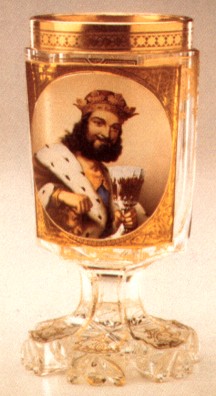|
| ||
|
|
||
|
Many of the ancient peoples worshipped a special god of beer, one of the oldest man-made drinks. For the Sumerians it was Nin-Harra, the Goddess of Fertility. The Egyptians worshipped the godly siblings, Isis and Osiris. Even Dionysius (Bacchus), who was honored by the Greeks of antiquity as the God of Wine, appears to have initially been considered the God of Beer. In Poland and Prussia homage was paid to Rauguzemapat, which can roughly be translated as "Lord of Fermentation." Drinking sacrifices were demanded in his honor: Of every freshly tapped keg of beer the lord of the house personally had to empty the first draught in Rauguzemapat's name! However, the real God of Beer, still accepted as such today, is Gambrinus: He is supposed to have invented beer. As patron saint of brewers and beer drinkers alike, he has enjoyed their adoration ever since the 16th century.
Better known among students of beer is the version that the name "Gambrinus" was taken from "Jan Primus," as Johann the First was known. This Jan Primus, a Flemish prince of the middle ages, is supposed to have been much enamored of the barley juice. A painting from the beginning of the 16th century, now in the German Brewing Museum in Munich, shows Gambrinus, together with beer brewing utensils, as a crowned sovereign. This God of Beer, similar to his portrait on the old painting, is also illustrated on a valuable glass pokal now in the Rastal Collection of Historical Drinking Vessels (Höhr-Grenzhausen, Germany) - see accompanying illustrations. This pokal has a cylindrically cut six-membered foot embellished with leaf ornaments; the stem and bowl each have six facets. On the bowl's front is a polished rectangular field, on which is engraved an oval medallion. On this is shown a masterful transparent painting of the bust of Gambrinus: The bearded God of Beer, crowned and wearing an ermine mantel, looks at us with a friendly smile. In his left hand he holds a pokal which is obviously filled with dark beer. In keeping with the rank of the person represented and the preciousness of the vessel, the remaining surfaces of the pokal are decorated with gold painting. The creator of this beautiful drinking vessel is one of the most famous artistic craftsmen of the Biedermeier period, the Viennese porcelain and glass painter Anton Kothgasser. Kothgasser was employed as design artist of the Imperial Porzellanmanufaktur (Porcelain Factory) in Vienna from 1784 until his retirement in 1840. He also had the privilege of working as a Hausmaler, a free-lance decorator. In his private workshop, at the Spanischen Spitalberg Nr. 227 in Vienna, he created - presumably with the assistance of other artists - his well-known drinking vessels, mostly decorated with scenes of Vienna and flowers, but also with portraits, allegories and playing cards. The Gambrinus Pokal originated in Kothgasser's workshop around 1835. On the base of the pokal, at the rear, are the painted signature initials, "A.K." This outstanding beautiful drinking vessel is 210 mm (8¼ inches) tall, and is in perfect ("mint") condition. Click here to view a larger image of the portrait on the pokal. |
|
All rights reserved. |
 ~ The
Gambrinus Pokal ~
~ The
Gambrinus Pokal ~
